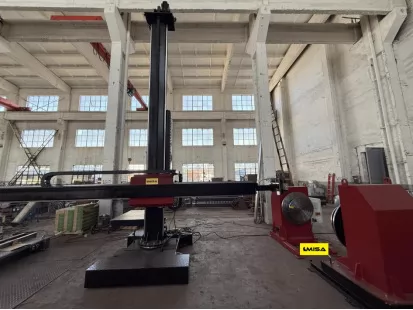


.png)
.png)
.png)

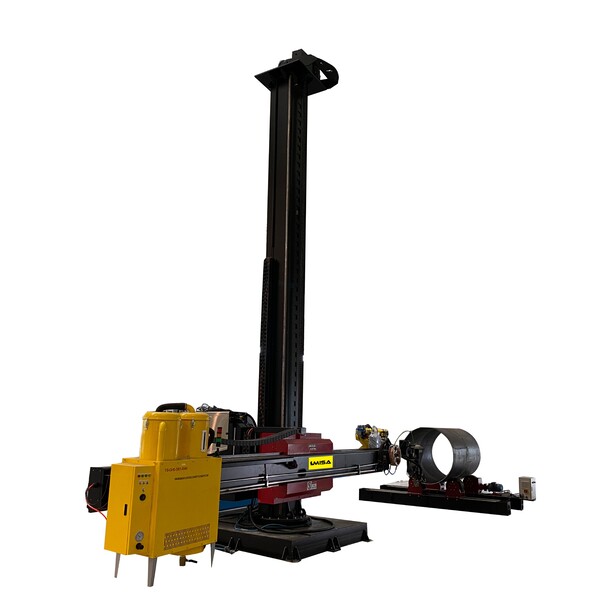
MISA LH-6060 Welding Column and Boom Manipulator main body box type welding structure is treating by stress after welding and fine machining shall be made. The guide surface adopts precision grinding processing or ensure the sophistication and smooth running. The precision grinding rack is installed on crossbeam to guarantee its flexibleness and free expansion and contraction. The crossbeam’s expansion and contraction, motor-driven turning of column and running of motor-driven trolley adopt AC f
Vertical 6M, Horizontal 6M Stroke
Fixed & Motorized Moving Optional
Linear Guide Rail Lifting
Basement Pneumatic Locking Device
VFD Control
200x200mm Cross Slide
CE/ UKCA/ CSA/ SGS



The automatic welding center is composed of three series of varieties, including welding column and boom, welding rotator, welding positioner, etc.
And is used in conjunction with DC automatic submerged arc welding machine.
The electrical appliances can be controlled individually or can be controlled in a trinity. Metal structural parts are automatically welded, with convenient and flexible operation, reliable performance, and strong matching.
It is an ideal welding equipment to ensure welding quality and improve work efficiency.
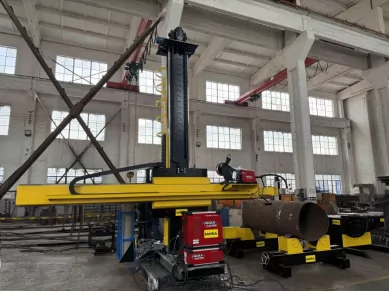 It can be purchased as a set or as a single piece, and can be designed and manufactured according to user requirements.
It can be purchased as a set or as a single piece, and can be designed and manufactured according to user requirements.
1. Welding type: SAW/MAG, MIG, TIG.
2. Optional: Cross fine adjustment, weld tracking system, flux recovery system, etc.
3. Welding method: Inside welding, Outside welding.
4. Vertical stroke and Elevation stroke can be customized according to requirements.
5. It can be used with Welding Turning Roll (Welding Rotator) or Welding positioner to realize automatic welding.
Welding Manipulator With Welding Turning Rolls Welding Manipulator With Welding Positioner
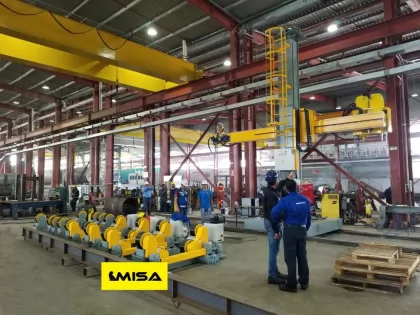
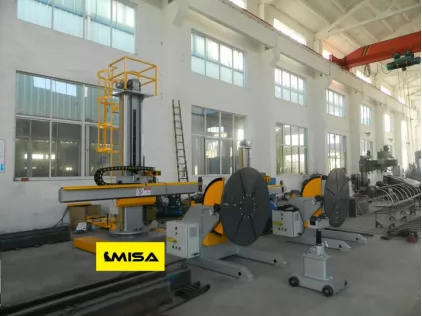
√ Standard match with CUL and CE
√ Professional design team
√ Motor power supply is equipped with safety protection
√ Perfect after-sales
√ 13 months warranty.
The welding manipulator also called welding column and boom, cross welding, telescopic submerged arc automatic cantilever welding. This product is used for automatic welding of inner and outer circumferential seams and inner and outer longitudinal seams of marine products in boiler, chemical, pipe making and other industries.
The welding manipulator is generally composed of columns, boomms, slewing mechanisms, trolleys and other components. It is a device that sends and maintains the welding head or welding gun at the position to be welded, or moves the flux along a specified track at a selected welding speed.
Do you have a lot of questions about the welding manipulator? We have compiled some common instructions on the use of the column and boom for you.
What Is A Welding Manipulator/ Column And Boom?
Welding manipulator is just one of many devices that help you to carry out the welding production process more conveniently.
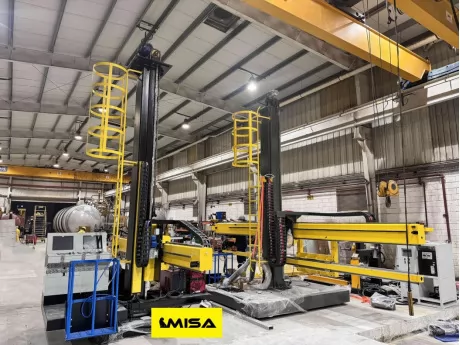
Sample of what a welding column and boom looks like
As a welding auxiliary machine, the welding manipulator can choose the welding system according to the customer's process requirements. The horizontal arm of the equipment adopts frequency conversion stepless speed regulation, and the speed is stable. The machine head is equipped with an electric cross fine-tuning mechanism to fine-tune the welding position. The lifting of the horizontal arm is equipped with a safety device to prevent chain breakage and sliding, and the rotation of the column is equipped with a brake device, which is safe and reliable.
The welding manipulator is a special equipment that combines a welding rotator and a welding positioner.
It can automatically weld the inner and outer circumferential seams, fillet welds, inner and outer longitudinal seams of the parts.
It has fixed, rotating, all positions and other structural forms.
According to user needs, we can choose the structure and match various welding machines, and add auxiliary functions, such as tracking, swing, monitoring, flux recovery and transportation.
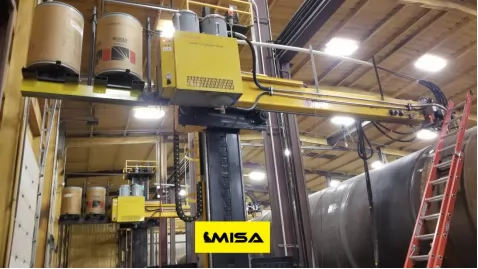
The picture of the welding manipulator at work
The welding manipulator is used to move the welder or automatic welding head to the required position for welding, so as to facilitate manual welding, semi-automatic or automatic welding. It can also ensure the stability of the welding process.
When welding workpieces with large diameters, it is usually difficult to reach high heights by manual operation. Therefore, the welding head can be moved to the welding seam with the help of the welding manipulator.
The manipulator has helped a lot in many large-scale welding production operations.
Generally, different versions and types of welding manipulators have different parts.
However, there are several types of components that are common to all types of manipulators, and they will definitely have them.
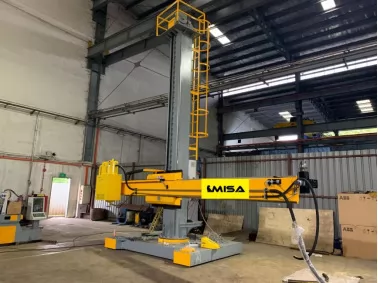
1. The operating device includes a guide rail, an inclination adjustment mechanism, a vertical guide mechanism, a welding gun clamp and a welding gun. The inclination adjustment mechanism allows the welding gun to rotate positively and negatively around the center.
2. The control device is composed of an electrical control system, which can control the working state of the welding manipulator.
3. The power source device is composed of air cylinders, which are driven by air pressure for power transmission.
4. The process guarantee device is composed of a wire guide mechanism, a wire guide tube and a wire guide nozzle, which can realize the automatic guiding and positioning of the welding wire and guarantee the quality of the welding seam.
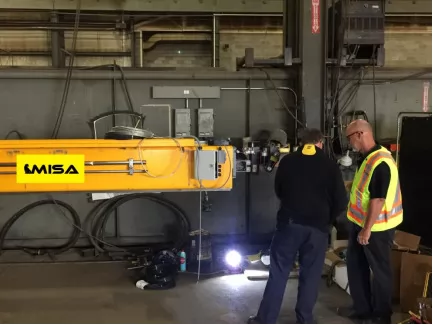
Obviously, the welding manipulator can realize automatic welding, thus improving work efficiency and providing greater flexibility. At the same time, the use of the welding manipulator reduces the fatigue of the welder and ensures the consistent quality of the welding operation.
Among them, the manual manipulator makes the movement speed faster through the built-in rotating casters, and the motorized welding manipulator can be operated manually or by a computer. Switching from one workstation to another is no longer as time-consuming and laborious as before. Even the welder can manually transfer the manipulator to any place in the workshop.
1. It allows more mobility during your operations.
2. It provides a safer working environment.
3. It's the ideal equipment for automating your welding operations.
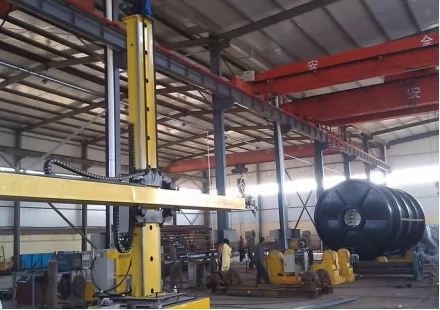 `
`
1. For positioning welding equipment
2. Accurate reach and lift range from 4 feet to 30 feet
3. Rack and Pinion Lifting System-Chainless Lift
4. The base can be fixed, portable or installed on a rail car
5. Kingpin rotation can be used for mast
6. Seam welding of equipment
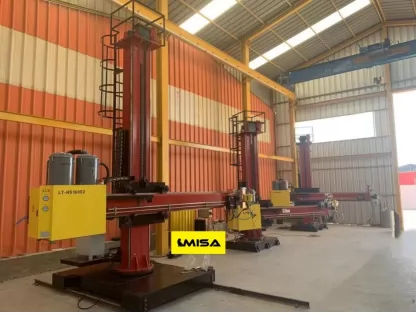
To choose the right size of your welding manipulator, you must not only determine the required vertical stroke range and horizontal stroke range, but also determine the load capacity you need the equipment to achieve.
Among them, the horizontal stroke range is selected according to the required arc horizontal limit position. The vertical stroke range is selected according to the vertical limit position of the arc.
1. Model from LH-1515-LH9090, please confirmed before you order.
2. Three structure of the column and boom: Stationary ; Stationary and revolve ; Moving and revolve , Please confirmed before you order.
3. Voltage standard is 380V , 50HZ , 3PH. We can customized other voltage.
4. We can design that the electric box control, the manipulator and rotator together
5. With cross turning for the welding head.
6. We could equip Welding machine(SAW, TIG, MIG) and flux recovery machine.
1. What are the welding methods?
SAW、MIG、TIG
2. What is the difference between welding methods? How to choose?
SAW: Suitable for thick steel plate
MIG: Suitable for thin steel plate and aluminum plate
TIG: Suitable for stainless steel plate
You can choose the suitable welding method according to the material of the welding workpiece, and our professionals can make recommendations.
3. What is the flux recovery system?
The flux recovery system can heat the flux, transport and recycled.
4. Can your equipment be customized?
Yes. We have a professional design team, which can be customized according to customer requirements.
5. Do you provide warranty?
We provide a 13-month warranty and can provide customers with technical guidance for life.
1. Welding Equipment Brands
Lincoln Electric: One of the largest and most respected welding companies in the world, offering a wide range of welding machines, consumables, and automation solutions.
Miller Electric: Known for its high-quality welding equipment, including MIG, TIG, and stick welders, as well as plasma cutters.
ESAB: A global leader in welding and cutting solutions, offering advanced equipment for various industries.
Fronius: Renowned for its innovative welding technologies, particularly in TIG, MIG, and arc welding.
Kemppi: A Finnish company known for its reliable and user-friendly welding machines and systems.
OTC Daihen: A Japanese brand specializing in welding robots and automation solutions.
Hypertherm: Famous for its plasma cutting systems, often used in conjunction with welding equipment.
2. Automation and Robotic Welding Brands
Fanuc: A global leader in industrial robotics, including robotic welding systems.
ABB: Offers a wide range of robotic welding solutions and automation technologies.
KUKA: Known for its advanced robotic welding systems and automation solutions.
Panasonic: Provides robotic welding systems and welding equipment for various industries.
3. Niche and Regional Brands
EWM: A German brand known for its high-performance welding machines and innovative technologies.
Lorch: Specializes in high-quality TIG and MIG welding machines.
Cigweld: An Australian brand off
Welding rotators are devices used to assist in the rotation of cylindrical workpieces during welding or other fabrication processes. They are typically used for pipes, tanks, and other cylindrical objects that need to be rotated evenly for welding purposes. These rotators help ensure a consistent weld seam by rotating the workpiece at a controlled speed, which allows for better access to the weld joint and reduces the need for the welder to reposition themselves during the process.
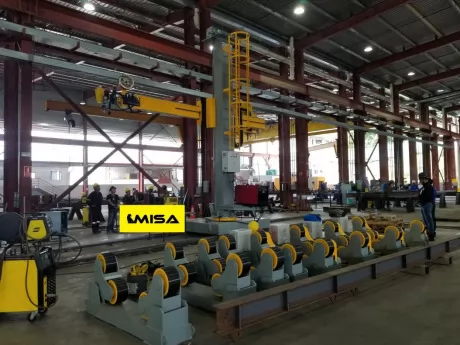
Choosing the right welding rotator involves considering several factors to ensure it meets the specific requirements of your welding operations. Here are key considerations when selecting a welding rotator:
1. Weight Capacity: Determine the maximum weight of the cylindrical workpieces you typically weld. Choose a welding rotator with a weight capacity that comfortably exceeds the heaviest workpiece you anticipate handling to ensure safety and efficiency.
2. Diameter Range: Consider the range of diameters of cylindrical workpieces you work with. Ensure the welding rotator's roller or wheel configuration can adjust to accommodate the minimum and maximum diameters of your typical workpieces.
3. Rotation Speed and Control: Evaluate the rotation speed range and the control mechanism offered by the welding rotator. Different welding processes and materials may require varying rotation speeds for optimal welding quality. Look for rotators that offer adjustable speed control to meet these requirements.
4. Drive System: Welding rotators typically use either rubber wheels, steel wheels, or adjustable rollers to rotate the workpiece. Choose a drive system that suits your application—rubber wheels are suitable for lighter loads and delicate surfaces, while steel wheels provide more robust support for heavier workpieces.
5. Power Source: Consider the power requirements of the welding rotator. They may be powered by electric motors, hydraulic systems, or pneumatic systems. Choose a power source that aligns with the availability and compatibility in your workshop environment.
6. Automation and Integration: Determine if you need automation features or integration capabilities with your welding equipment. Some welding rotators can be integrated with welding positioners or automated welding systems for synchronized operation and improved productivity.
7. Build Quality and Durability: Look for welding rotators made from sturdy materials such as high-quality steel or aluminum alloys. Ensure they have robust construction and durable components that can withstand the demands of your welding operations over the long term.
8. Safety Features: Consider safety features such as emergency stop buttons, overload protection, and secure locking mechanisms to prevent accidents and ensure operator safety during operation.
9. Cost and Value: Assess the initial purchase cost, considering your budget and the expected return on investment based on improved productivity, reduced labor costs, and enhanced weld quality.
10. Supplier Reputation and Support: Choose a reputable supplier or manufacturer with a track record of providing reliable welding rotators and excellent customer support. Consider factors such as warranty coverage, technical support, and availability of spare parts.
By carefully evaluating these factors and understanding your specific welding requirements, you can choose a welding rotator that enhances efficiency, safety, and welding quality in your workshop or manufacturing facility.Or consult MISA and we will tailor a solution for you.
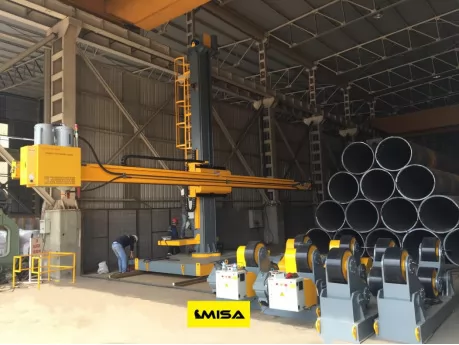
After the welding manipulator is integrated with the welding rotator, it is widely used in fields that require high-precision and high-efficiency welding, especially in the welding of cylindrical or annular workpieces.
1. Pipeline welding
- Application areas: pipeline manufacturing and installation in the oil, natural gas, chemical, water conservancy and other industries.
- For circumferential welding of long-distance pipelines. Pipeline butt welding to ensure uniform welds and good sealing.
- Automated welding improves efficiency, reduces manual errors, and is suitable for mass production.
2. Pressure vessel manufacturing
- Application areas: large-scale pressure vessel manufacturing in the chemical, energy, food and other industries.
- Mostly used for welding of cylinder circumferential and longitudinal seams, or butt welding of heads and cylinders.
- It is convenient to ensure that the quality of welds meets the safety standards of high-pressure vessels and improve production efficiency.
3. Tank manufacturing
- Applied to the manufacture of large storage tanks such as oil storage tanks and water treatment storage tanks.
- Specifically used for circumferential and longitudinal seam welding of storage tank cylinders, and splicing welding of large tank bottom plates.
- Suitable for welding large-diameter workpieces to ensure uniformity and strength of welds.
4. Wind power tower welding
- Mainly used for tower manufacturing of wind power generation equipment. Such as tower segment circumferential seam welding, tower longitudinal seam welding.
- It can meet the high requirements of wind power equipment for welding quality and adapt to the welding of large-diameter and thick-walled workpieces.
5. Boiler manufacturing
- Automated production of industrial boilers, power station boilers and other equipment. Targeting the circumferential seam and longitudinal seam welding of boiler cylinders, and the butt welding of boiler pipes.
- The automated production line ensures the reliability and durability of welds under high temperature and high pressure environments.
6. Ship building
- For welding of ship pipelines, hull sections and other components. Such as circumferential seam welding of ship pipelines, and butt welding of hull sections.
- It can improve welding efficiency and meet the requirements of high strength and sealing in shipbuilding.
7. Steel structure manufacturing
- Application areas: manufacturing of large steel structures such as bridges, buildings, and towers. For the circumferential welding of cylindrical steel structures and the splicing welding of large steel components.
- Suitable for welding of large-size workpieces to ensure structural strength and stability.
8. Aerospace component manufacturing
- Applicable to the welding of pipes, shells and other parts of aerospace equipment. High-precision circumferential welding, and butt welding of thin-walled parts.
- The welding roatator with the welding manipulator can meet the extremely high requirements of the aerospace field for welding accuracy and quality.
9. Automobile manufacturing
- For the welding of automobile exhaust pipes, drive shafts and other parts. Circumferential welding of exhaust pipes, and butt welding of drive shafts.
10. General machinery manufacturing
- Welding of cylindrical parts of various mechanical equipment. Circumferential welding of rollers and shaft parts. Splicing welding of large mechanical parts.
- Advantages: Applicable to a variety of workpiece types, improving welding quality and production efficiency.
The integration of welding manipulators and welding rotators is widely used, especially for the welding of cylindrical and annular workpieces. Its high degree of automation can significantly improve welding efficiency and quality, while reducing labor costs and labor intensity. In the fields of pipelines, pressure vessels, storage tanks, wind power equipment, boilers, ships, aerospace, etc., this integrated equipment has become an indispensable welding solution.
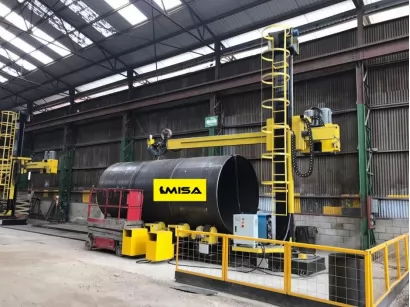
This type of welding positioner provides powered rotation of a work-piece, and in addition gives powered gear driven control of the table tilt. The table can be tilted from horizontal, through vertical to 90 degrees past the vertical. This type is often called a “Flat - 135 degree” Positioner. Powered table rotation is variable speed to permit making circumferential welds at any desired speeds. Gear driven positioners are offered from 1,000 lbs. to 1,000,000 lbs. capacity. Various accessories extend the versatility of these units.
MISA’s welding positioners enable better weld seam accessibility to the weldment, creating increased deposition rates. Even less experienced weld operators can safely manipulate our units while concentrating on welding functions. The design takes up minimal floor space and allows unrestricted movement throughout the work area. Many safety features have been incorporated into the structural, mechanical and electrical components of these positioners to ensure safe, productive operation. A large selection of optional equipment includes: back-lash control, variable speed tilt, and optional tables.
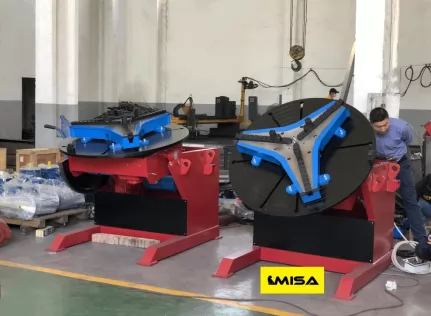
The integrated application of welding manipulator and welding positioner is an important combination in modern welding automation, especially suitable for multi-angle and multi-position welding of complex workpieces. This integration can significantly improve welding efficiency, precision and consistency, and is widely used in various industrial fields.
1. Improve efficiency: Automated welding reduces manual intervention and significantly improves production efficiency.
2. Ensure quality: Multi-angle welding ensures uniform welds and reduces defects.
3. Strong adaptability: Suitable for complex workpieces and multi-position welding needs.
4. Reduce labor intensity: Automated operation reduces the labor intensity of workers and improves the working environment.
5. High flexibility: Welding parameters and positions can be adjusted according to the shape and size of the workpiece.
The integrated application of welding manipulator and welding positioner is an important development direction of modern welding automation, especially suitable for complex workpieces, large structural parts and high-precision welding needs. This combination plays an important role in pressure vessels, wind power equipment, shipbuilding, automobile manufacturing, aerospace and other fields, and can significantly improve welding efficiency and quality while reducing production costs and labor intensity.
